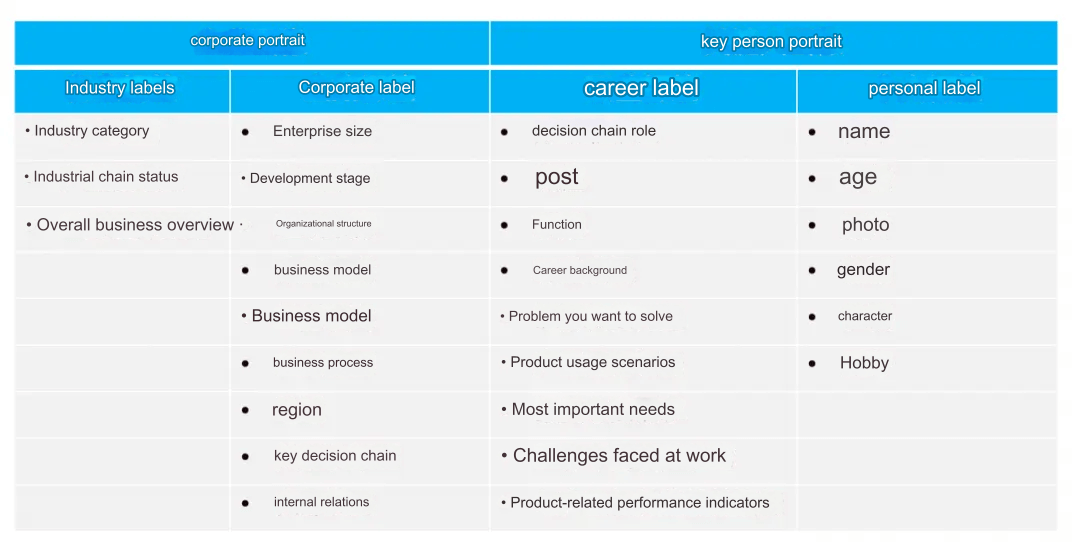This article explores the challenges and pitfalls businesses face when serving customers through a thought-provoking case study. It deeply analyzes why companies, despite significant investments, still fail to retain their customers. The article emphasizes the importance of constructing an Ideal Customer Profile (ICP) and its application in marketing. The goal is to help businesses more accurately target their ideal customers, improve customer satisfaction and loyalty, and achieve sustainable business growth. It aims to offer new insights for service providers to optimize their customer relationship management strategies.
A while ago, during a conversation with a friend, a case was brought up that left a lasting impression and sparked deep reflection.
They had assigned their best product managers, R&D teams, and even customer success managers—investing top resources and a considerable amount of manpower and financial input to develop a product. However, after the product launch, not only did the client not adopt the product smoothly, but it also led to customer churn.
The root cause of the problem lies in this: They excelled in retail CRM but blindly ventured into the manufacturing CRM market at the end of last year. Despite the high contract value of the project, and after several internal discussions on whether to accept it, the company couldn't resist the allure of a high-priced project amid tough market conditions. They also saw it as an opportunity to break into the manufacturing industry. However, they underestimated the difficulty of crossing into a new domain, leading to massive investments but ultimately failing to retain customers.

1. Choosing the Wrong Target Customer Is Fatal
Trying to serve manufacturing clients with a retail CRM product was a strategic misstep. Due to significant differences in business processes and management needs between the two industries, such cross-sector attempts often end in failure. It’s like a romantic relationship—if the two parties' values are misaligned and one is not the ideal partner, no matter how much effort is put in, it will be difficult to achieve a satisfactory result, and both sides may end up hurt.
2. Failing to Deeply Understand Customer Needs
To successfully serve clients, it is crucial to deeply understand their needs and usage scenarios. For unsuitable clients, if the service provider lacks a deep understanding of their needs and contexts, the service provided may merely respond mechanically to client demands, without genuinely solving their problems. Sometimes, the clients themselves may not fully understand their needs, so even if the product is developed according to their requirements, it may not satisfy them in the end.
In such cases, service providers must have the capability to guide clients, helping them clarify their needs and offering solutions that truly address the issues. Even if the best products, technology, and customer service teams are employed, without correctly utilizing these resources or solving the customers’ actual problems, the outcome will fall short.
The competition in the enterprise service market is intensifying in 2024. If resources are not maximized, not only will you lose customers, but your business could also face operational difficulties.
So, how should we deal with these challenges?
The essence of enterprise service products is to meet customer needs. Therefore, we must constantly examine who our target customers are and what their real needs are. Only by deeply understanding the customers and accurately grasping their needs can we clearly define the value proposition of our products. In this process, understanding the Ideal Customer Profile (ICP) is crucial.
3. The Key to Choosing the Right Customers: Ideal Customer Profile (ICP)
In the market for enterprise service products, the Ideal Customer Profile (ICP) is a critical concept that plays an indispensable role in precise marketing and efficient customer acquisition, helping us select the right customers.
01 What Is the Ideal Customer Profile (ICP)?
The concept of an Ideal Customer Profile originated from market segmentation and was initially described primarily using demographic data to define the target market. As marketing science advanced and data analysis techniques evolved, businesses began to use more complex datasets to construct customer profiles, such as incorporating psychological and behavioral analysis to better understand customers. With the application of big data and artificial intelligence technologies, the construction and use of ICPs have become more refined and dynamic, able to reflect market changes and customer needs in real-time.
In the B2B sales of enterprise services, ICP typically refers to the ideal customer profile, a model of the most suitable potential customers for a company’s product or service, constructed through in-depth research and data analysis. This description includes not only the basic information of customers, such as industry attributes, company size, and geographical location, but also deeper characteristics like behavioral traits, business needs, purchasing decision processes, and preferences. It also involves the attributes of key decision-makers within the company, such as their professional background and role attributes. Specifically:
ToB Customer Profile = Industry Characteristics + Company Characteristics + Key Decision-Maker Profile
The key content of a customer profile is outlined in the table below: (Ideal Customer Profile Chart)

02 The Role of Ideal Customer Profiles (ICP)
The market is vast, but not all of it is available to us. Especially in the early stages of a business, trying to capture everything often leads to capturing nothing. The Ideal Customer Profile (ICP) points us toward a serviceable, accessible market, helping us accurately identify and understand the most valuable customer groups, which hold high-value information that enables more precise product positioning and marketing strategies. By deeply analyzing and depicting the characteristics of ideal customers, it aids in refined application, enhances profitability and efficiency, and ultimately improves customer experience and service quality, thereby maximizing business value.
The ICP helps quickly verify the accuracy of product positioning and allows for swift strategic direction adjustments, ensuring we have detailed information about vertical sectors and better understand our customers. It helps market and sales teams understand who the customers are, what services they need, and how to focus on the core value customers offer, empowering sales teams to operate more efficiently. With an ICP, teams can more easily identify target customers and move them through the stages of incubation, conversion, signing, and renewal.
For product managers, the ICP helps define the product’s positioning and goals, with the profile informing design strategies and planning, ensuring that the product better meets the needs of target customers.
Lastly, the ICP also helps customer service teams deliver personalized and refined services, thereby improving customer satisfaction and loyalty.
4.The Importance of the Ideal Customer Profile (ICP)
In the marketing of enterprise service products, the importance of the Ideal Customer Profile (ICP) cannot be overstated. It serves as the strategic foundation for acquiring customers and improving sales efficiency.
01. Focusing on ICP Improves Efficiency
Resources such as time and money are limited for businesses, so using them efficiently is critical for survival and growth. By building and focusing on an ICP, companies can more accurately identify and engage potential customers who are most likely to purchase their products. This allows marketing and sales efforts to be concentrated on high-value customer groups, rather than being wasted on groups that might have no interest in the product. This focus significantly improves conversion rates in marketing campaigns and overall sales efficiency.
02. Drives Business Consistency and Eases Consensus
The ICP provides a clear and unified understanding of target customers within a company. Teams from product development, marketing, sales, and customer service can all make decisions based on the same customer information, leading to consistency in product design, marketing strategies, sales approaches, and customer service. This internal consistency helps create a cohesive brand image and enhances collaboration between departments, improving overall business efficiency.
03. Maximizes Resource Utilization and Facilitates Niche Market Penetration
Understanding the specific characteristics and needs of ideal customers allows a business to allocate resources more precisely, whether in advertising through specific media channels or showcasing products at targeted industry events. This precise positioning maximizes resource utilization and helps businesses deeply penetrate niche markets, building a strong brand advantage and standing out in competitive environments.
04. Enhances Customer Satisfaction and Retention, Leading to Customer Success
The ICP is not only useful for acquiring customers, but it also plays a key role in maintaining and developing existing customer relationships. When a company deeply understands its customers’ needs and can provide solutions that meet those needs, customer satisfaction increases significantly. Satisfied customers are more likely to become repeat buyers and even advocates for the brand. Additionally, improving customer retention directly contributes to predictable and stable revenue, which is critical for a company’s long-term success.
5.Five-Step Method to Create an ICP
Building an ICP is vital for the success of B2B enterprise service products. It is a process of refining customer profiles, and here is a five-step method to construct an accurate ICP:
Data Collection
Data Analysis
Initial Creation of the ICP
Validation of the ICP
Optimization and Adjustment of the ICP
Step 1: Data Collection
To begin creating an ICP, companies need to gather as much relevant data as possible. This data may include, but is not limited to:
Internal Data:
Product Data: Particularly data related to highly active enterprises.
Management Information: The ideal customer profile in the minds of company executives.
Employee Insights: Ideal customer profiles from the perspectives of product, R&D, marketing, sales, and customer success teams.
Sales Data: Data from successful deals, marketing events, customer research, and service data.
External Data:
Market and Competitive Intelligence: Understanding competitors’ market share, product advantages, and customer feedback.
Industry Trends: Factors such as new technologies, regulatory changes, and supply chain information that could affect customer needs and behavior.
This data can be collected through various channels, such as CRM systems, sales team feedback, customer surveys, online behavior analysis tools, and social media monitoring tools.
Step 2: Data Analysis
Once the data is collected, the next step is analyzing it—arguably the most important step in creating the ICP. The goal is to organize and analyze the disparate data points and tags to better identify common characteristics among ideal customers and to make the customer profile more tangible and humanized.
In particular, the focus should be on highly active companies that are using the product. Analyze these companies' characteristics and key personnel, combining insights from product, sales, and customer success data to extract common traits. For example, if a CRM SaaS system is used intensively by companies in a specific medical equipment sector, further analysis of the reasons for usage, solutions offered, and value achieved will help refine the ICP. By doing so, the company could dominate a niche market.
Step 3: Initial Creation of the ICP
After data analysis, an initial ICP can be constructed. However, creating a comprehensive ICP involves more than simply outlining customer traits. To ensure this tool is most effective across key business areas like sales, marketing, and product development, the ICP must be detailed and expanded.
Customer Characteristics:
Industry category: Healthcare, manufacturing, etc.
Company size: Annual revenue between $100 million and $200 million.
Development stage: Rapid growth or Series B funding.
Location: Tier-2 or Tier-3 cities.
Key decision-makers: Marketing director, decision influencers.
Problems to be solved: Need for full control over sales operations, rapid market entry.
Work challenges: Process and result management, etc.
Customer Progress: The ICP should include customer progress by combining job-to-be-done (JTBD) tasks to clarify the significant changes that occur after adopting the product or service. This analysis compares pre- and post-adoption states and details how the product drives progress and delivers value to customers.
Customer Journey: The ICP should also include the customer journey, focusing on decision-making from the customer’s perspective, identifying key touchpoints where the company can build relationships with customers. A customer journey map can be created, visually showcasing the entire lifecycle from first contact to adoption.
User Journey: For B2B service procurement, the user journey needs to be refined for different roles in the decision-making chain. By tailoring touchpoints and content for each key role, the company can accelerate the procurement decision-making process.
Step 4: Validation of the ICP
Once the initial ICP is created, it must be validated through actual market testing using methods such as:
Customer Feedback: Directly ask customers about their needs and preferences to see if they align with the ICP.
A/B Testing: Compare the responses of different customer groups to marketing activities and identify which group aligns more closely with the ICP.
Sales Feedback: Gather frontline insights from sales teams.
Case Studies: Study the most successful customers to see if they match the ICP characteristics.
Step 5: Optimization and Adjustment of the ICP
Since markets and customer needs evolve, it’s essential to periodically optimize and adjust the ICP. This may involve:
Tracking Customer Feedback: Continually gathering feedback to refine the ICP.
Monitoring Market Trends: Updating the ICP to reflect new market dynamics.
Using Data Analysis: Employ new data analysis techniques to deepen the understanding of customer behavior.
By following this five-step method, businesses can build an accurate ICP, laying a solid foundation for success. This approach not only helps businesses acquire and maintain customers more effectively, but also enhances overall market competitiveness.
6. The Application of Ideal Customer Profile (ICP)
In B2B enterprise product marketing, deeply understanding and effectively applying the Ideal Customer Profile (ICP) is essential. Below is a case study demonstrating the application of ICP, using CRM software tailored for customer management in the healthcare industry as an example.
1. Understand Your Buyer
Buyers in the healthcare industry face a unique purchasing decision process. They need to ensure that the CRM system they select can address the specific challenges of the healthcare sector, such as patient relationship management, compliance tracking, and appointment scheduling. By constructing an Ideal Customer Profile, CRM providers can gain deep insights into the buyer’s specific needs, industry characteristics, purchasing behavior, and decision-making processes.
Based on these insights, businesses can create a healthcare industry customer journey map, detailing the full process from when the customer becomes aware of a problem, explores solutions, evaluates vendors, and makes a purchasing decision. This helps businesses craft precise marketing strategies at each touchpoint, effectively converting potential customers into actual buyers.
2. Optimize and Adjust Marketing Strategies
As the healthcare market changes dynamically and customer feedback accumulates, CRM providers need to continuously adjust and optimize their marketing strategies.
The insights provided by ICP help businesses identify which marketing activities are most effective and which require adjustment. For instance, data analysis may show that professional healthcare seminars are an effective way to attract high-quality prospects. As a result, the business can consider increasing the budget and frequency of these activities. Moreover, ICP can guide businesses on which channels (such as healthcare industry forums or professional conferences) to focus their marketing efforts to maximize return on investment.
3. Creating an ICP Marketing Toolkit
Once the ICP for the healthcare industry is clearly defined, CRM providers can create a targeted marketing toolkit that includes customized presentations, case studies, white papers, email templates, and social media content.
For example, if the ICP indicates that healthcare customers are more concerned with improving patient satisfaction and operational efficiency, the marketing materials should emphasize how the CRM system optimizes patient service processes and enhances the operational performance of healthcare institutions. Such personalized content can more effectively attract target customers and help build the brand's image as a specialist in healthcare industry solutions.
4. Provide a Personalized Purchasing Experience
In the healthcare sector, customers expect highly customized services. Using ICP, CRM providers can offer a tailored purchasing experience for each potential client. This includes personalized demonstrations during the sales process, targeted product configuration recommendations, and training and implementation plans designed specifically to meet the client’s needs.
This personalized service not only increases customer satisfaction but also strengthens customer loyalty, helping businesses gain a competitive advantage in a highly competitive market.
7. Common Pitfalls of ICP
While understanding and applying ICP is crucial in B2B product marketing, businesses may encounter some common pitfalls in practice. Here are several typical mistakes and how to avoid them.
1. Overgeneralization
A common mistake is creating an overly generalized ICP, which offers little value for actual marketing activities. For example, if a CRM provider considers "all healthcare institutions" as their target customers, the profile becomes too broad. The healthcare industry encompasses numerous subfields such as general hospitals, specialty clinics, and research labs, each with unique needs and challenges.
Therefore, ICP should be more specific. For instance, it might focus on private hospitals, community health centers, or specialized medical labs, helping CRM providers more accurately target their marketing strategies.
2. Ignoring Customer Needs and Pain Points
Another common pitfall is ignoring the actual needs and pain points of the customer. Healthcare customers might face issues such as inefficient patient data management, cumbersome clinical workflows, or compliance challenges. CRM solution providers must ensure that their ICP not only includes basic customer information but also thoroughly understands the customer's business operations and key challenges. By incorporating these needs and pain points into the ICP, CRM providers can better demonstrate how their products address these critical issues and establish stronger connections with potential customers.
3. Relying on Assumptions Rather than Data
Some businesses may base their ICP on subjective assumptions instead of data. For example, a CRM provider might assume that large hospitals need their product the most without conducting actual market research to verify this. Such assumptions can lead to wasted resources, as smaller clinics or specialty medical centers might need flexible and customizable CRM systems more. Therefore, ICP construction should be based on market data, customer feedback, and actual sales experience to ensure its accuracy and effectiveness.
4. Failing to Align ICP with Business Strategy
Another common mistake is not aligning the ICP with actual business strategy and objectives. If the CRM provider’s business goal is to expand market share, the ICP should reflect underserved potential customer groups in the market. The creation of ICP is not just a part of marketing activities; it should be closely linked to the company’s overall strategy, guiding decisions in product development, sales methods, and customer service.
5. Failing to Update ICP Regularly
The market environment and customer needs are constantly changing, and ICP needs to be updated regularly. Some CRM providers might create an ICP at one point in time and continue to use it without modification. This approach is not ideal. With the emergence of new technologies, shifts in market competition, and evolving customer demands, ICP should be adjusted accordingly. Regular review and updates to ICP ensure that it reflects the current market reality, which is crucial for maintaining a company’s market responsiveness and competitiveness.
8. Conclusion
The Ideal Customer Profile (ICP) plays a critical role in modern enterprise precision marketing and customer acquisition strategies. By deeply understanding customer insights and performing detailed analysis, ICP enables businesses to precisely target their market, thereby optimizing product design and marketing strategies to significantly improve sales performance and customer satisfaction.
Focusing on an ICP strategy not only enhances the precision of marketing but also promotes business process consistency, optimizes resource allocation, and boosts customer satisfaction and loyalty. To construct an effective ICP, businesses must thoroughly understand buyer needs, carefully map customer journeys, continuously optimize marketing strategies, and offer highly personalized purchasing experiences. However, businesses must avoid common pitfalls, such as creating overly broad customer profiles, neglecting real customer needs, relying on assumptions instead of data, and failing to align ICP with actual business strategy.
Through scientific and meticulous ICP construction and application, businesses can solidify their position in competitive markets and achieve sustainable growth.
With advancements in big data and artificial intelligence, ICP construction and application are becoming more refined and dynamic, driving customer analysis toward deeper segmentation, more customized customer experiences, and more flexible and evolving customer profiles. This trend may lead to the evolution of ICP into Perfect Customer Profiles (PCP), which not only cover the critical information in ICPs such as industry background, company size, regional distribution, budget, and core needs but also expand into more detailed areas such as purchasing habits, procurement cycles, and transaction frequency. This allows companies to more accurately target their customer base, significantly improving sales efficiency and conversion rates.






